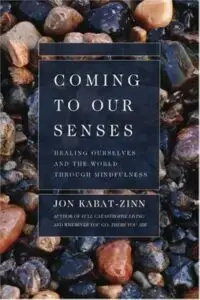
Coming to Our Senses
Healing Ourselves and the World Through Mindfulness
Jon Kabat-Zinn
Hyperion (2005) • First Edition 2004
- Emotional, Spiritual
- Book, Premium Content, Resource Summary
Key Takeaways
- Mindfulness is already inside you. Meditation isn’t something you “learn”; it’s a natural capacity to pay attention to the present moment.
- Any posture works. Sitting, walking, standing, or lying down can all foster mindful awareness—pick what feels possible today.
- Thoughts shape symptoms. Noticing thoughts without judgment can calm the nervous system, easing pain, fatigue, and sensory overload common in FND.
- Healing ripples outward. One person’s steadier nervous system can create a calmer home, caregiving relationship, and community.
Click to read full summary
The Essentials
Jon Kabat-Zinn explains mindfulness as the simple—but challenging—practice of being fully present without judging what you find. By tuning in to sights, sounds, breath, and body sensations, you step out of endless mental chatter and into direct experience. The book walks through practical ways to meditate while reclining, sitting, standing, or walking, making the practice accessible to nearly anyone.
Research highlighted here shows that Mindfulness-Based Stress Reduction (MBSR) can strengthen the immune system, shorten healing time for conditions like psoriasis, and ease emotional distress. Kabat-Zinn argues that when individuals calm their own minds, they also reduce conflict and reactivity in the wider world.
Why This Matters for FND
People with Functional Neurological Disorder often experience a dysregulated nervous system, unpredictable symptoms, and medical gaslighting. Mindful awareness offers a low-cost, flexible tool to settle the body’s threat response, improve interoception, and build confidence in your own sensations. Because you can practice in bed, in a waiting room, or on a short walk, mindfulness adapts to fluctuating energy and mobility levels
Resource Qualities
Applicability:
Accessibility:
Evidence-Based:
Practical Value:
Practical Applications
For Individuals with FND
Low-Energy Days
- Try a 2-minute body scan before getting out of bed: notice toes → calves → knees → hips, simply feeling each area without judging.
Building Long-Term Wellness
- Schedule a 5-minute walking meditation after meals. Count ten slow steps, turn, repeat. Track how your symptoms shift over a month.
For Care Partners
Supporting Your Loved One
- Offer a quiet co-breathing session: sit together, match slow inhales and exhales for three breaths to reduce shared stress.
- Encourage (but don’t push) your loved one’s practice by maintaining a calm household routine—dim lights, limit sudden noises during flare-ups.
Caring for Yourself
- Use a standing “tree” meditation while waiting in line: feel your feet and imagine roots for 60 seconds.
- Join a local or online MBSR group to build your own resilience and model self-care.
When This is Most Helpful
- Newly diagnosed and feeling overwhelmed
- During symptom flares that involve pain, dizziness, or sensory overload
- When care partners need quick resets to prevent burnout
This summary is provided for informational purposes only and does not constitute medical, financial, or legal advice. It is not intended to replace professional consultation or treatment. Always consult qualified providers regarding your specific circumstances, symptoms, or questions.
